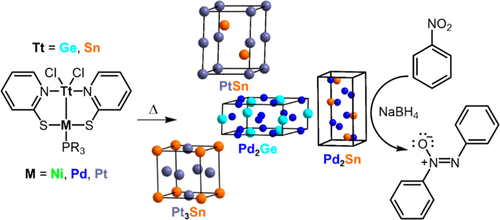当前位置:
X-MOL 学术
›
Organometallics
›
论文详情
Our official English website, www.x-mol.net, welcomes your feedback! (Note: you will need to create a separate account there.)
Intermetallic Nanocatalysts from Heterobimetallic Group 10–14 Pyridine-2-thiolate Precursors
Organometallics ( IF 2.8 ) Pub Date : 2020-03-03 , DOI: 10.1021/acs.organomet.9b00803 Carena L. Daniels 1 , Megan Knobeloch 1 , Philip Yox 1 , Marquix A. S. Adamson 1 , Yunhua Chen 1 , Rick W. Dorn 1, 2 , Hao Wu 3 , Guoquan Zhou 3 , Huajun Fan 4 , Aaron J. Rossini 1, 2 , Javier Vela 1, 2
Organometallics ( IF 2.8 ) Pub Date : 2020-03-03 , DOI: 10.1021/acs.organomet.9b00803 Carena L. Daniels 1 , Megan Knobeloch 1 , Philip Yox 1 , Marquix A. S. Adamson 1 , Yunhua Chen 1 , Rick W. Dorn 1, 2 , Hao Wu 3 , Guoquan Zhou 3 , Huajun Fan 4 , Aaron J. Rossini 1, 2 , Javier Vela 1, 2
Affiliation

|
Intermetallic compounds are atomically ordered inorganic materials containing two or more transition metals and main-group elements in unique crystal structures. Intermetallics based on group 10 and group 14 metals have shown enhanced activity, selectivity, and durability in comparison to simple metals and alloys in many catalytic reactions. While high-temperature solid-state methods to prepare intermetallic compounds exist, softer synthetic methods can provide key advantages, such as enabling the preparation of metastable phases or of smaller particles with increased surface areas for catalysis. Here, we study a generalized family of heterobimetallic precursors to binary intermetallics, each containing a group 10 metal and a group 14 tetrel bonded together and supported by pincer-like pyridine-2-thiolate ligands. Upon thermal decomposition, these heterobimetallic complexes form 10–14 binary intermetallic nanocrystals. Experiments and density functional theory (DFT) computations help in better understanding the reactivity of these precursors toward the synthesis of specific intermetallic binary phases. Using Pd2Sn as an example, we demonstrate that nanoparticles made in this way can act as uniquely selective catalysts for the reduction of nitroarenes to azoxyarenes, which highlights the utility of the intermetallics made by our method. Employing heterobimetallic pincer complexes as precursors toward binary nanocrystals and other metal-rich intermetallics provides opportunities to explore the fundamental chemistry and applications of these materials.
中文翻译:

异双金属10-14吡啶-2-硫代吡啶盐前体的金属间纳米催化剂
金属间化合物是原子序有序的无机材料,在独特的晶体结构中包含两种或多种过渡金属和主族元素。与许多催化反应中的简单金属和合金相比,基于第10组和第14组金属的金属间化合物显示出更高的活性,选择性和耐久性。尽管存在制备金属间化合物的高温固态方法,但较软的合成方法可提供关键优势,例如能够制备亚稳相或制备具有增大表面积的较小颗粒用于催化。在这里,我们研究了二元金属间化合物的杂化双金属前驱物的广义族,每个前体包含结合在一起并由钳状吡啶-2-硫醇盐配体支撑的10族金属和14族t。热分解后 这些杂双金属配合物形成10-14个二元金属间纳米晶体。实验和密度泛函理论(DFT)计算有助于更好地理解这些前体对特定金属间二元相合成的反应性。使用钯以2 Sn为例,我们证明以这种方式制得的纳米粒子可以作为独特的选择性催化剂,将硝基芳烃还原为a氧基芳烃,这突出了我们方法制备的金属间化合物的实用性。将异双金属钳形配合物用作二元纳米晶体和其他富含金属的金属间化合物的前体,为探索这些材料的基本化学方法和应用提供了机会。
更新日期:2020-04-24
中文翻译:

异双金属10-14吡啶-2-硫代吡啶盐前体的金属间纳米催化剂
金属间化合物是原子序有序的无机材料,在独特的晶体结构中包含两种或多种过渡金属和主族元素。与许多催化反应中的简单金属和合金相比,基于第10组和第14组金属的金属间化合物显示出更高的活性,选择性和耐久性。尽管存在制备金属间化合物的高温固态方法,但较软的合成方法可提供关键优势,例如能够制备亚稳相或制备具有增大表面积的较小颗粒用于催化。在这里,我们研究了二元金属间化合物的杂化双金属前驱物的广义族,每个前体包含结合在一起并由钳状吡啶-2-硫醇盐配体支撑的10族金属和14族t。热分解后 这些杂双金属配合物形成10-14个二元金属间纳米晶体。实验和密度泛函理论(DFT)计算有助于更好地理解这些前体对特定金属间二元相合成的反应性。使用钯以2 Sn为例,我们证明以这种方式制得的纳米粒子可以作为独特的选择性催化剂,将硝基芳烃还原为a氧基芳烃,这突出了我们方法制备的金属间化合物的实用性。将异双金属钳形配合物用作二元纳米晶体和其他富含金属的金属间化合物的前体,为探索这些材料的基本化学方法和应用提供了机会。


























 京公网安备 11010802027423号
京公网安备 11010802027423号